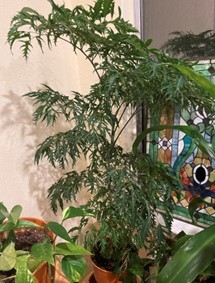My Goldilocks Plant
When we bought our Ming aralia it was this stumpy thing with almost no foliage, not my idea of a plant I'd like to own. Fortunately, my husband fell in love with the plant, and home it went. It has been living with us for years, in health, in decline (more on this later!), and renewal.
Polyscias fruticosa is a perennial, dicot, evergreen shrub, or dwarf tree, which is exactly what it looks like. The name polyscias is a reference to the “many-shaded” leaves found on this plant. It comes from the family Araliaceae and there are at least six species of this plant that are currently cultivated. One of Ming aralia distinctive characteristics is its unusual leaf shape. The leaves are shiny, dark green, and are tripinnate (a term I had never heard before!) Tripinnate leaves have bipinnate leaflets that are arranged on either side of the rachis. The leaves are glossy, lanceolate, irregularly lobed, have serrate margins, and are approximately 4” long. They grow in an opposite leaf arrangement. The stems are a lovely reddish, brown color. The plant itself while a slow grower can reach heights from 3'-8'.[1] Mine was 6' in height before it began to decline. [2]
The name “Ming” refers to the Asian origin of the species. It is native to the tropics of Southeast Asia and the tropical islands of the Pacific Ocean. It is famous as an ornamental houseplant but is also a popular bonsai specimen as it can be trimmed not to grow above a foot. This plant will flower in all seasons with blooms that grow as panicles up to 6” long producing white to gold/yellow flowers. Ming aralia thrives in USDA zones 11-12 and in this climate can be grown as outdoor shrubs.
I saved a cutting from my original plant, rooted it in water, and when well rooted, planted it in a well-draining soil mix. This mix consisted of two parts peat moss, two parts loam, and one part sand or perlite. You can also take a green stem cutting in the spring and place them in damp soil (with a rooting hormone to give it that extra boost.) Make sure the new cutting has plenty of warmth (try placing potted cutting on a seedling heating mat) and moisture (misting in addition to watering) and in a few weeks you will have rooted cuttings.
While researching this blog, I discovered the possible causes of my plants' decline. I learned how sensitive this plant can be and discovered that the two causes of decline are sudden changes of temperature and over-watering. This is my “Goldilocks” plant. The plants' soil likes to be moist but never saturated with temperatures ranging between 65 and 85 degrees Fahrenheit. You can avoid over-watering by watering early in the day with tepid water until you see a slight runoff. Any more than that should be removed. Having rocks in your runoff dish is helpful as well for preventing root rot which this plant is sensitive to. To avoid salt build-up, using distilled water is preferable. Repot annually as needed or every other year. I always repot when I see roots jutting from the bottom of the pot.
On a positive note Ming aralia is fairly pest resistant but can be susceptible to aphids, scale, mealybugs, and spider mites (I've had none!) If so spray with insecticidal soap or a neem oil solution consisting of one tablespoon in a half gallon of water. [3] Given the right conditions this plant will be a welcome addition to your plant collection both for its graceful beauty and its ability to bounce back and thrive after being exposed to less than ideal conditions.
This is a cutting I took from my declining plant that was grown in optimal conditions- “not too hot or not too cold, but just right!” My Goldilocks plant![4]
[1] Wikipedia page on Polyscias fruticosa
[2] North Carolina Extension Gardener Plant Toolbox
[3] The Spruce- “How to Grow and Care for Ming Aralia” by Jon Vanzile
[4] All photos taken by the author of her own plant.

ming 2


